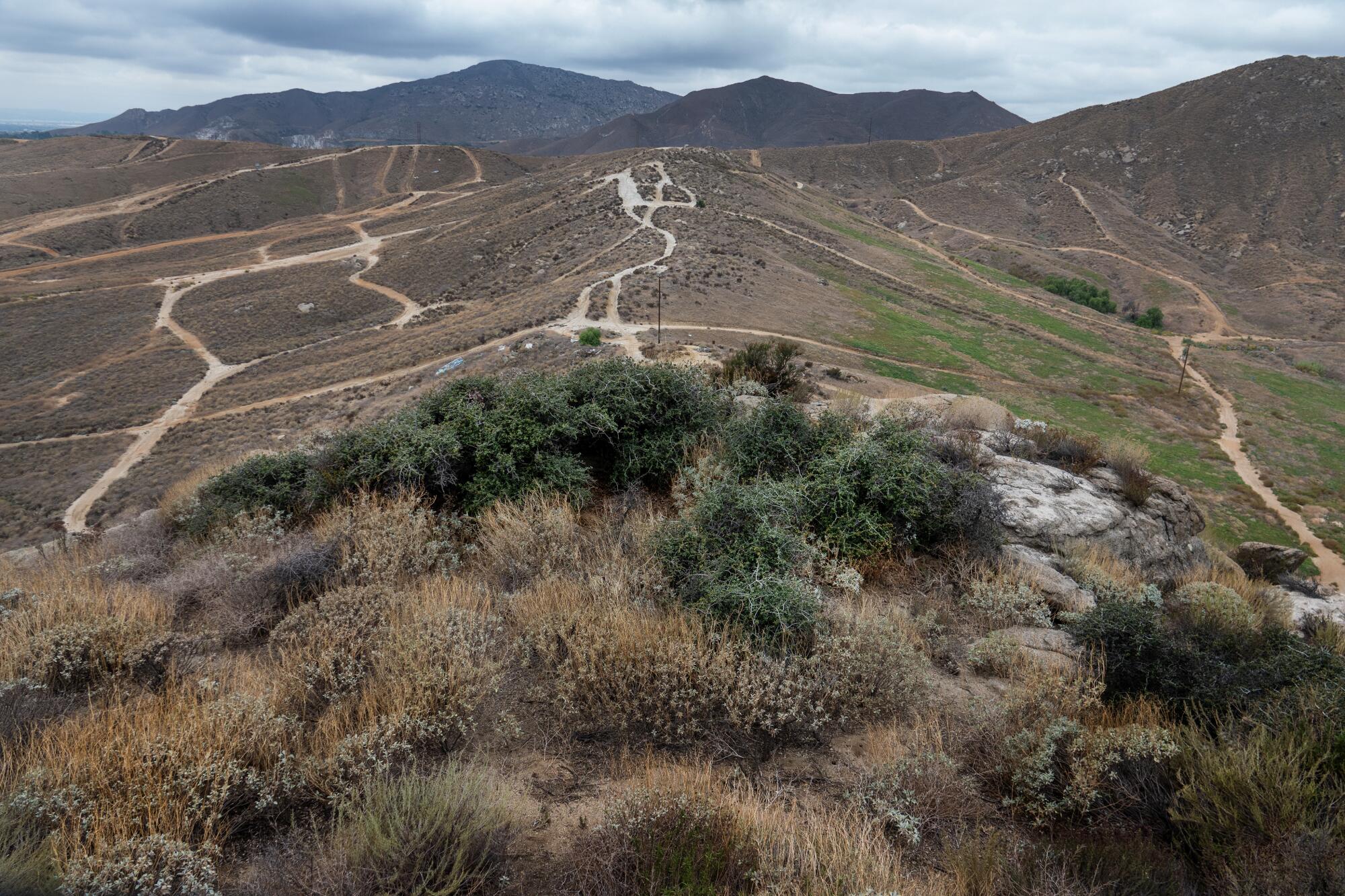- Share via

JURUPA VALLEY, Calif. — After a contentious five-hour public meeting, environmentalists advocates have persuaded Inland Empire officials to delay development of a project within 400 feet of one of the oldest known plants in the state and the third-oldest in the world.
“Tonight has been a real learning process,” Jurupa Valley City Planning Commission Chair Penny Newman said at the Thursday meeting. “I think we all need time to process the information we’ve had here tonight.”
The commission voted unanimously to table the vote. Members said the developers must do more studies into the potential effects on the plant, a Palmer oak, and further explore protective measures. Commissioners also requested more details on a plan to transfer ownership of the tree and surrounding land to a local tribe, who would oversee its conservation.
“We have discovered a treasure on the world stage here in our humble city,” lifelong Jurupa Valley resident Jennifer Iyer said at the meeting. “In a city known for its toxic waste dump, the worst air quality in the nation … let’s have a plan that protects and celebrates something unique that makes us proud.”
The roughly 370-acre development would include residential housing, an elementary school, a business park and industrial buildings. It would leave the tree on a 27-acre rocky outcrop, but it would come within 400 feet of the plant. Scientists and tribal members say the oak has been around for at least 13,000 years — surviving the last ice age and, more recently, the founding of the United States.
Members of the Shiishongna Tongva Nation, the Corona Band Of Gabrieleño Indians and the Kizh Nation, Gabrieleño Band Of Mission Indians have lived in the Santa Ana River Basin for millennia as well. Both groups regard the tree as sacred.
“We’ve known about this tree forever,” said Michael Negrete, chief and chairperson of the Shiishongna Tongva Nation. “It gives medicine. It gives oxygen. It gives life to the animals.”
Companies have been trying to develop the land since the early 1990s, with Richland Communities presenting the current plan in 2019. After discussions with the City Planning Commission and the public, it has replaced potential warehouses with light industrial space and a business park, increased the amount of open space, and committed to transfer ownership and conservation responsibilities of the land with the Palmer oak to a Native tribe or conservation organization.
Richland Communities announced at the meeting that it had reached an agreement in concept to transfer the land to the Kizh Nation and provide them with a $250,000 initial endowment for conservation. Company executives also proposed requiring the agreement to be finalized before construction begins on the industrial and business sections, which are closest to the tree.
Commissioners want additional information on the plan’s details and how conservation of the land would be legally enforced. Richland Communities did not respond to a request for comment.
Compared with rugged California live oaks, the Palmer oak looks more like a shrub and is made up of individual stems sprouting in a grove. It wasn’t until fairly recently that researchers determined its impressive age.
Mitchell Provance, a botanist and associate researcher at UC Riverside, first noticed the oak more than two decades ago and found it odd that it lived isolated from other members of its species in an area that was much lower and hotter than where the trees usually grow. He began discussing the tree with his colleagues. They hypothesized that it was the last holdout from a time when the region was cooler and wetter — a much friendlier environment for the oaks.
To see if this was the case, the researchers collected samples from dead stems, which had identical DNA. Whenever the tree was damaged by a fire, it would resprout from the base of its trunk. By using tree rings to estimate how much the trunk can grow in a year, the team was able to calculate the tree’s age by measuring the grove’s diameter.
Today, the grove measures 80 feet wide, which led researchers to estimate that the tree is between 13,000 and 18,000 years old. It’s possible that the tree has been able to reproduce with itself, instead of just resprouting from the trunk to produce clones, but this is unlikely, experts say.
While the company has worked with the environmental consultant FirstCarbon Solutions to study the impact of construction vibrations on the tree and identify potential water sources, it has not mapped the tree’s root system or confirmed its direct water source — a process that would involve chemical testing of water at the oak’s roots.
Some also worry the proposed development would expose the aged oak to the urban heat island effect — a phenomenon in which developed areas can run 1 to 7 degrees higher than shaded, natural areas during the day.
Aaron Echols, the conservation chair of the Riverside/San Bernardino California Native Plants Society, said it was the duty of conservation groups to point out potential effects on the tree that haven’t yet been studied. “The burden to mitigate impacts … that’s on the applicant and the consultant.”

The portion of the environmental impact review discussing the Palmer oak — including its exact location — has been redacted from public documents. The city was required to do this by law, since the tree has sensitive cultural significance to the Native tribes. Consequently, independent scientists have been unable to scrutinize the report.
The city said it would explore “creative ways” to legally allow a select few third-party experts to view and discuss the report.







